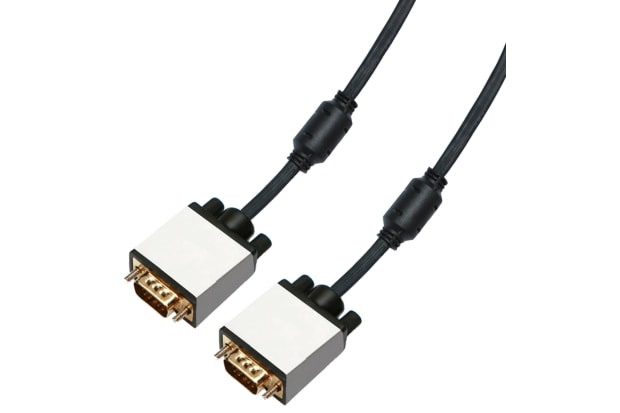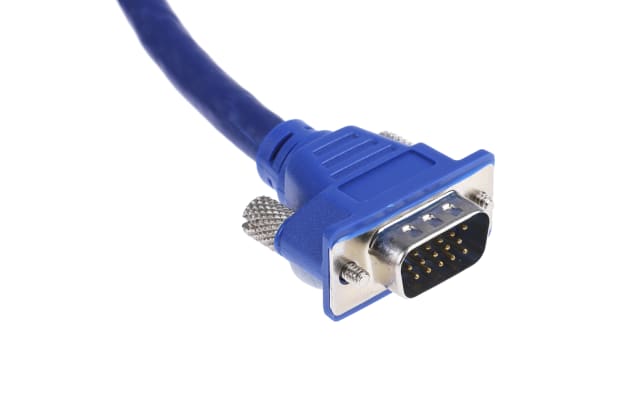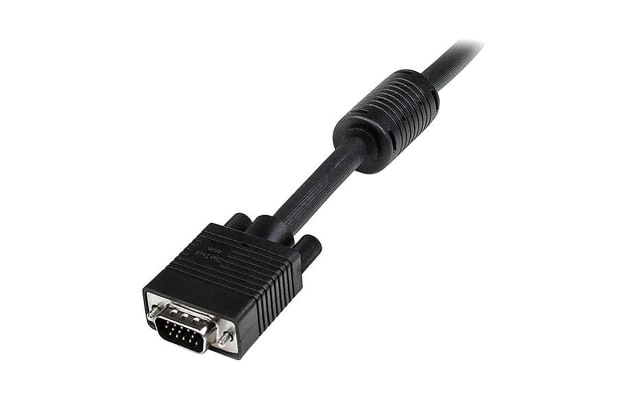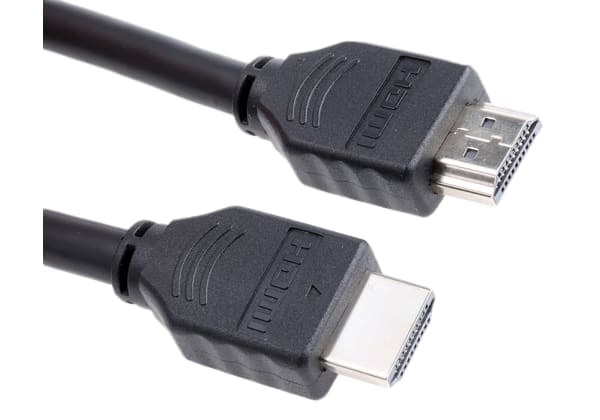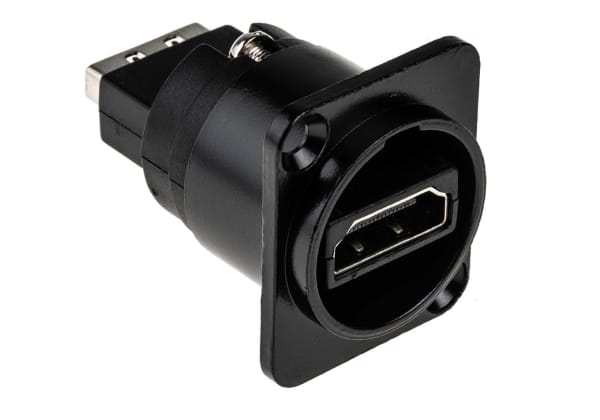- Published 11 Jan 2023
- Last Modified 25 Nov 2025
- 8 min
VGA Cables - A Complete Buyers' Guide
Find out about the different types of VGA cable, their uses, and which are the best products in our buyers' guide.

What is a VGA Cable?
VGA cables were first introduced during the late 1980s. Since then, 15-pin VGA cables have become a widely used standard for connecting various types of electronic devices that use video signals. The acronym VGA stands for Video Graphics Array and is commonly heard today as something of an umbrella term for various types of cable/connector that share a common base pin layout and socket format.
These familiar VGA cables and their instantly recognisable 15-pin connectors are frequently found in both home and office desktop PC setups, usually carrying a visual signal from a desktop computer to a monitor VGA input. Similarly, they’re also used for linking various other types of video output devices - such as laptops, video cards, projectors, and certain varieties of set-top boxes - to TVs, monitors, all-in-one PCs, and various other types of screened display peripherals.
Standard VGA cables remain vital for establishing a reliable video or graphics link between computers, monitors, projectors and high definition television sets in both domestic and commercial environments. It’s more common for smaller devices (such as compact laptop computers) to have a mini-VGA port installed, as opposed to a full-sized VGA connector, but these miniature versions play exactly the same role in terms of graphical signal transfer.
In this guide, we’ll give an overview of what VGA cable types are available and look a bit more closely at how they’re used, defined, and differentiated. We’ll also address a few frequently asked questions about VGA cables, including ‘what is a VGA port symbol?’ and ‘what’s the difference between VGA and newer standards like HDMI?’.
What Does a VGA Cable Do?
The earliest configurations of VGA cables initially came to market in 1987. Through various minor revisions and iterations by other manufacturers in the years that followed, the format quickly settled to become one of the most common standard configurations for computer cabling assemblies.
Today, we still see VGA sockets and cables in use on a large number of PCs, laptops, TVs and monitors. The most familiar and easy way to identify a VGA cable is the classic three-row, 15-pin connector (designated DE-15, and commonly referred to as D-sub miniature or D-sub) at either end.
These connectors can be either male or female, and are commonly - but not always - flanked by a matching pair of captive thumb screws. When positioned on either side of the connector itself, these screws can be tightened after insertion to create a more secure connection with the socket. As noted above, this will typically be a monitor VGA input socket, the corresponding laptop VGA input port, or a similar application such as a suitable socket on the rear of a TV.

VGA cables are designed to carry an analogue video signal between various types of electrical devices and components. Each of the VGA connector’s socket pins plays a role in transferring and displaying some aspect of an RGBHV video signal. In this context, RGBHV stands for red, green, blue, horizontal sync, and vertical sync. When output by a PC, laptop, or video/graphics card, these elements combine to form a cohesive video signal which is then viewable on a monitor or other device screen at the other end of the VGA cable.
These cables have numerous unique features which make them especially well-suited for the job. Over the following sections, we’ll outline some of the different types of VGA cables and look at a range of other important properties, variables and accessories. We’ll briefly cover a few key elements of VGA cable buying such as gendered connectors or VGA adapters/splitters, and identify some of the market-leading brands known for high-quality VGA cables and components.
VGA Cable Types
There are numerous different types of VGA cables and compatible variants. Despite being an older connection standard, this reflects the fact that VGA ports are still found on a huge number of modern computers, monitors, laptops, TVs, graphics cards and other video-related peripherals and devices.
In addition to VGA and SVGA cables themselves, most manufacturers and suppliers will also offer a range of VGA cable adapters and splitters, as well as numerous other compatible connectors, features and accessories.
The main distinction you’ll need to be aware of when shopping for VGA cables is the technical difference between VGA and SVGA.
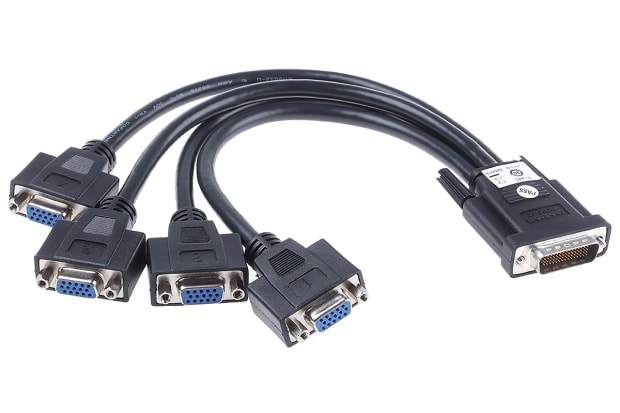
VGA cables
VGA cables (Video Graphics Array) carry analogue video signals and are typically designated for supporting video resolutions up to and including 640 x 480.

SVGA cables
SVGA cables (Super Video Graphics Array, or less commonly referred to as enhanced or ‘ultra’ VGA) also carry analogue video signals but are generally used to support resolutions up to and including 800 x 600.
VGA Connector Genders
VGA connectors are gendered and come in both male (pins/plug) and female (holes/socket) variants. Most VGA cables are identified in terms of reference to the gender of connector A and connector B, or a similar naming scheme, as this allows you to select the right configuration for the connection you’re trying to make between devices.
Even so, depending on the specific type of cable in use and the precise configuration of the connection you need to make at the PC or monitor end, you may require the use of various VGA adapters, extenders and splitters in order to create a working connection for a particular setup. Widely available adapter/splitter options for gendered VGA cables include:
- VGA male to male adapter
- Male to female VGA adapter
- Female to male VGA adapter
- Female to female VGA adapter
VGA Connector and VGA Adapter Types
There is a wide range of VGA connector types available today, reflecting the number of different devices - both new and legacy - that still make use of this connection type. Increasingly, VGA connectors are used alongside or in combination with other newer standards such as DVI connectors and HDMI cables.
The terminology here is sometimes used rather interchangeably when it comes to labelling various types of VGA cable and can be a little vague. However, the basic or standard VGA connector type will usually be referred to as some variant of the following: DE-15, HD15, VGA plug, SVGA plug, D-Sub 15 or D-Subminiature, or the more generic RGB connector.
In addition to the standard D-sub connector type at one end of a VGA cable, products with various other types of adaptor or connector types at the opposite end are widely available. Common configurations of VGA cable connectors and adapter ends include:
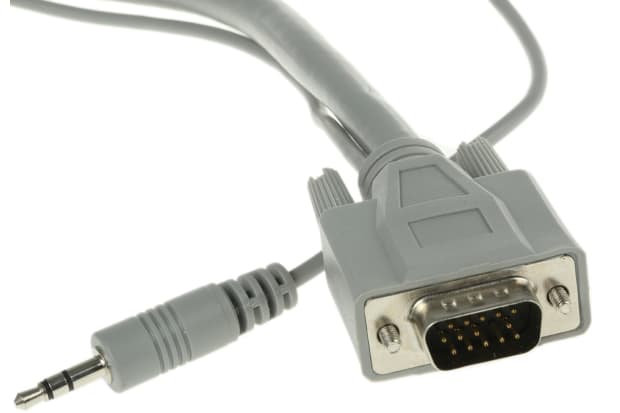
- D-Sub HD15 VGA
- SVGA HD15
- VGA to HDMI Cable
- VGA to DVI-D
- VGA to DVI or DVI-I
- VGA Male to Female
- VGA Female to Male
- USB to VGA
- VGA to Mini-Jack
- VGA to Phono
VGA Cable Brands
There are a huge number of companies worldwide that manufacture VGA cable, although differences can be noticed as a result of the varying construction methods and materials that are used. If in doubt, it’s always best to opt for a reliable cable from a well-known manufacturer as opposed to an option which may be cheaper but is likely also worse quality.
Among the various market-leading suppliers of branded VGA cable, some key names to look out for include the following.
Popular Brands
Cable Power
Cable Power is one of the go-to specialists in the professional electronics industry for HDMI and VGA cabling, leads, splitters, and more.
Matrox
Matrox has over 40 years’ experience designing software and hardware solutions for graphics, video, and imaging/machine vision application
RS Pro
RS Pro is our in-house line, manufactured to the same standards we demand from our external suppliers but sold at a lower cost to you.
StarTech
Another highly rated and widely trusted supplier, StarTech is a global manufacturer of IT products specialising in cabling and connectivity.
